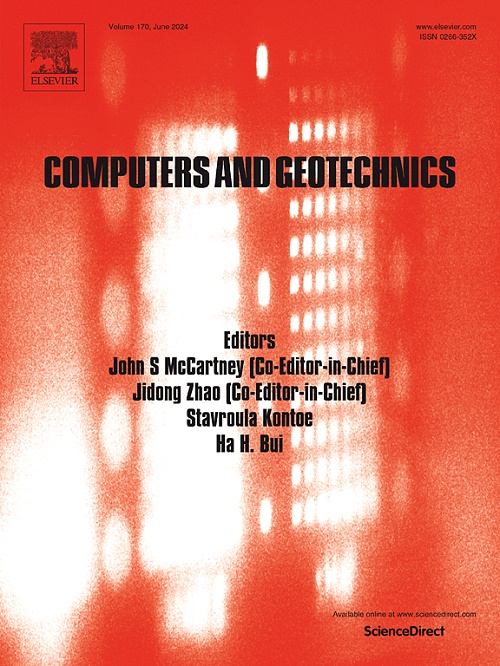Temperature-dependent hardening and constitutive modelling of frozen rocks: Insights into plastic energy dissipation
IF 5.3
1区 工程技术
Q1 COMPUTER SCIENCE, INTERDISCIPLINARY APPLICATIONS
引用次数: 0
Abstract
Fluctuating sub-zero temperatures trigger the phase transitions of ice and water in rocks within cold regions, resulting in a strong temperature-dependent nonlinear stress–strain relationship in frozen rocks. However, existing constitutive models for frozen rocks are established and derived at a given temperature, failing to consider the dynamic impact of temperature changes on plastic hardening and nonlinear mechanical behaviour, thus failing to accurately capture the stress–strain characteristics of rocks under temperature fluctuations. To address this issue, this study derives a hardening law from the perspective of energy dissipation and proposes a unified temperature-dependent constitutive model within a thermodynamic framework to accurately describe the stress–strain behaviour of frozen rocks under continuously changing temperature conditions. To validate its applicability, triaxial tests were conducted at specific temperatures on frozen coal rock and frozen sandstone, along with two multi-temperature uniaxial tests on frozen coal rock. A comparison between the computed results and experimental data reveals a high degree of agreement, demonstrating the reliability and accuracy of the proposed model. The results confirm that the proposed model not only captures the stress–strain behaviour of different frozen rocks at fixed temperatures but also effectively characterizes their mechanical response under dynamic thermal conditions, providing quantitative insights into the relationship between plastic energy dissipation and temperature. The constitutive model proposed in this paper offers new insights into the impact of temperature variations on the mechanical behaviour of frozen rocks and can be integrated into commercial finite element calculation software to provide more reasonable solutions for the mechanical behaviour of cold region rocks under arbitrary temperature changes.
冻结岩石的温度依赖硬化和本构模型:对塑性能量耗散的见解
零下温度的波动触发了寒冷地区岩石中冰和水的相变,导致冻结岩石中存在强烈的温度依赖非线性应力-应变关系。然而,现有的冻结岩石本构模型是在给定温度下建立和推导的,没有考虑温度变化对塑性硬化和非线性力学行为的动态影响,无法准确捕捉温度波动下岩石的应力-应变特征。为了解决这一问题,本研究从能量耗散的角度推导了硬化规律,并在热力学框架内提出了统一的温度相关本构模型,以准确描述连续变化温度条件下冻土的应力-应变行为。为了验证其适用性,分别对冻结煤岩和冻结砂岩进行了特定温度下的三轴试验,并对冻结煤岩进行了两次多温度单轴试验。计算结果与实验数据的比较显示了高度的一致性,证明了所提出模型的可靠性和准确性。结果表明,所建立的模型不仅能够捕捉到不同冻结岩石在固定温度下的应力-应变行为,而且能够有效表征其在动态热条件下的力学响应,为塑性能量耗散与温度之间的关系提供定量的见解。本文提出的本构模型为研究温度变化对冻结岩石力学行为的影响提供了新的视角,并可集成到商用有限元计算软件中,为冷区岩石在任意温度变化下的力学行为提供更合理的解。
本文章由计算机程序翻译,如有差异,请以英文原文为准。
求助全文
约1分钟内获得全文
求助全文
来源期刊

Computers and Geotechnics
地学-地球科学综合
CiteScore
9.10
自引率
15.10%
发文量
438
审稿时长
45 days
期刊介绍:
The use of computers is firmly established in geotechnical engineering and continues to grow rapidly in both engineering practice and academe. The development of advanced numerical techniques and constitutive modeling, in conjunction with rapid developments in computer hardware, enables problems to be tackled that were unthinkable even a few years ago. Computers and Geotechnics provides an up-to-date reference for engineers and researchers engaged in computer aided analysis and research in geotechnical engineering. The journal is intended for an expeditious dissemination of advanced computer applications across a broad range of geotechnical topics. Contributions on advances in numerical algorithms, computer implementation of new constitutive models and probabilistic methods are especially encouraged.
 求助内容:
求助内容: 应助结果提醒方式:
应助结果提醒方式:


